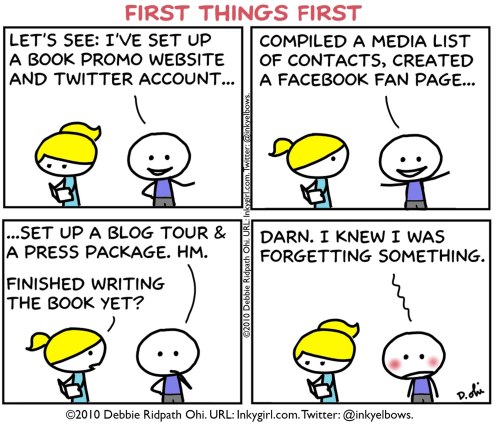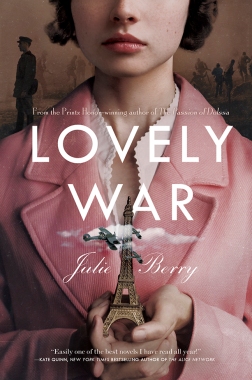Registration for the Marvelous Midwest Conference is full, but luckily another member of the faculty has agreed to be interviewed for our blog. Today we welcome author/illustrator Debbie Ridpath Ohi.

Debbie Ridpath Ohi received many rejections before getting her first big break (and a book contract!) at the 2010 SCBWI-LA conference, where her art was discovered in the portfolio showcase by Simon & Schuster publisher and editor, Justin Chanda. Debbie is the author and illustrator of Sam & Eva and Where Are My Books? (Simon & Schuster). Her illustrations and/or writing have appeared in two dozen books including titles by Michael Ian Black, Aaron Reynolds and Judy Blume. Upcoming book: I’m Worried, a new picture book written by Michael Ian Black and illustrated by Debbie (published by Simon & Schuster). Other upcoming projects include illustrations for a picture book by Linda Sue Park and a yet-uncontracted middle grade novel. You can find out more about Debbie and her work at DebbieOhi.com as well as on Twitter at @inkyelbows and Instagram at @inkygirl. Debbie is represented by Ginger Knowlton at Curtis Brown Ltd.

Your intensive is a Social Media Master Class for Authors and Illustrators. You plan to discuss how to promote yourself even if you are an introvert. Can we be true to ourselves and have a social media presence?
I find this question intriguing because in my opinion, the best type of social media presence happens when you ARE being true to yourself. If you aren’t, people will be able to tell. Or if they can’t tell, then eventually YOU will get tired of pretending to be someone you’re not.
I am an introvert, though some people don’t believe this. After crowded social situations like a cocktail party or a conference, no matter how fun, I need to re-energize with silence and solitude.
When I first realized that I needed to leave my safe hobbit-hole of an office and start meeting others in the industry, I was terrified. Terrified that no one would want to talk with me, terrified that I’d say the wrong thing, terrified of having to talk about myself instead of just staying in the background.
What I found: social media can be a great networking tool, especially for those who are more comfortable behind a screen than chitchatting with strangers in person. It’s good to get practice with the latter, of course! And eventually, I did find that this gradually got easier for me (and it can even be fun).
For me, social media was the perfect way to ease into the world of networking. Before I ever chose to post anything, I could read other people’s posts, see how they did it. I could think about my responses before replying. I could doublecheck spelling and facts before saying anything publicly.
Social media is also a great way to get to know and ”meet” others in the community before interacting them in person at a conference, making the latter much less awkward. I’ll talk more about this and offer some practical tips in my Social Media Masterclass for Authors and Illustrators workshop at the MMW conference.
![]()
Identifying one’s brand seems crucial. This seems like a dumb question, but sometimes I struggle with what a brand actually is—especially if one is just at the beginning of one’s career. Do you have thoughts on that?
This is NOT a dumb question!
A lot of people have a problem with the word “brand” because they associate it with commercial products like soup and toothpaste. When I was first asked to speak about personal brand, I had the same reaction. “I’m an individual, not a brand!”
Whatever term you use, the fact is that we all make choices when it comes to how we look and interact with people. You choose what clothes to wear for different occasions, how you interact with people in person, your reactions to what people say. These choices can vary, depending on the situation.
Similarly, you make choices when it comes to your public presence online: what aspects of your personality, life and work you choose to show and how you show them. Even if you decide to post EVERYTHING, good and bad, that is a deliberate choice.
So much about personal brand is about choices, consistency and public expectations. If people see you as “that illustrator who posts a lot of fascinating b&w drawings of cats as well as photos of her own cats”, then you’ll likely attract people who love cats as well as others. Editors and art directors looking for an artist to illustrate a middle grade novel that features cats will be more likely to think of you. Maybe you’ll be “that YA author with an office supply obsession, who posts hilarious and pithy comments about life” or “that picture book writer who is always so positive/enthusiastic and uses a lot of fun emoticons in her tweets” (for this last bit, who else immediately thought of the wonderful Ame Dyckman on Twitter?).
On the other hand, if you’re constantly just retweeting other people and never posting your own original content, then people won’t really see who YOU are. Or if you’re constantly complaining or being mean-spirited, then that will also influence how people see you in general….even if you aren’t really like that in real life.
You can always decide to change aspects of your personal brand, of course! But be aware of the potential complications. People tend to see me as an artist who posts mainly happy, cheerful and uplifting art, for example. As a result, I mainly get offered book illustration projects that need happy, cheerful and uplifting art. I do have other illustration styles, however, including a darker and creepycute style which I would love to use in a book someday, so have been gradually sharing some of those samples.
I’ll be talking more about this topic in my workshop.

Your breakthrough came at an SCBWI conference. Can you share what that experience was like?
It was amazing. Even though it all happened back in 2010, I confess there’s a tiny part of me that still keeps waiting to wake up and find out it was all a dream.
Thanks for calling it a breakthrough. It drives me a little crazy when people call me a Cinderella story, putting the emphasis on luck rather than any efforts on my part. YES, there is always an element of luck when it comes to having your work discovered and then championed by others in the industry. But I also am a firm believer in working hard to help create your own luck.
I had been trying to get noticed in the children’s book industry for many years. I wrote three middle grade novel mss, two submitted through my agent. I could tell I was getting better as well as gradually gaining some traction — the rejection letters were more personal and encouraging — BUT I could tell that I needed to venture out of my introverted office-cocoon and start meeting people. My friend Lee Wardlaw had encouraged me to go to SCBWI conferences, and I decided it was about time to listen to her advice.
I submitted my middle grade manuscript to the mss critique program but hadn’t read the rules closely — it ended up being rejected because I had included b&w illustrations in my middle grade manuscript sample. My friend Beckett Gladney, my sister and my husband convinced me to enter the portfolio showcase. Beckett, who was rooming with me, helped me put together my very first portfolio as well as making me a gorgeous handmade cover.
I ended up winning an Illustration Mentorship Award as well as an Honor Award! Not only did I receive valuable advice from each of my Mentors, but I also made new friends by keeping in touch with the other Mentees as well as Mentees from other years; you can find out more about us as well as what we’ve been learning over the years at KidLitArtists.com.
But wait….that’s not all! Justin Chanda was one of the judges for the overall Portfolio Showcase Awards, and he asked me if I’d like to illustrate a picture book by Michael Ian Black for Simon & Schuster Children’s. I said YES (of course), and that became my very first children’s book project: I’M BORED. Since then, I’ve illustrated many other picture books, helped revamp some Judy Blume classics, and also written and illustrated my own books.
At that time, you could not enter both the mss critique program as well as the portfolio showcase….which means that if I had not been rejected from the former, I would never have entered the latter. My takeaway: you never know when a rejection or failure will bring new opportunities, but you need to be flexible and open to those opportunities.
Thank you so much for sharing your insights. We look forward to hearing more from you in May!
If you have already registered for the Marvelous Midwest Conference, you can still add an intensive to your registration by contacting Darcy Zoells at notmrdarcy at gmail dot com.




 Julie Berry is the author of the 2017 Printz Honor and Los Angeles Times Book Prize shortlisted novel The Passion of Dolssa, the Carnegie and Edgar shortlisted All the Truth That’s in Me (2013, Viking), the Odyssey Honor title The Scandalous Sisterhood of Prickwillow Place (2014, Roaring Brook), and many others. Her latest middle grade novel, The Emperor’s Ostrich, released in 2017 from Roaring Brook. Her forthcoming young adult novel, Lovely War, releases from Viking Children’s Books in March 2019, and her first picture books will release in fall 2019. She holds a BS from Rensselaer in communication and an MFA in creative writing for children and young adults from Vermont College. She lives in Southern California with her family.
Julie Berry is the author of the 2017 Printz Honor and Los Angeles Times Book Prize shortlisted novel The Passion of Dolssa, the Carnegie and Edgar shortlisted All the Truth That’s in Me (2013, Viking), the Odyssey Honor title The Scandalous Sisterhood of Prickwillow Place (2014, Roaring Brook), and many others. Her latest middle grade novel, The Emperor’s Ostrich, released in 2017 from Roaring Brook. Her forthcoming young adult novel, Lovely War, releases from Viking Children’s Books in March 2019, and her first picture books will release in fall 2019. She holds a BS from Rensselaer in communication and an MFA in creative writing for children and young adults from Vermont College. She lives in Southern California with her family. The secondary character from another author’s work who comes immediately to mind is Rosa Hubermann from Markus Zusak’s The Book Thief. I’m sensing a curious connection – Rosa’s got a flair for colorful insults, too. She becomes Liesel’s foster mother. When we first meet Rosa, there’s every reason to believe she will fill the Wicked Witch or Evil Stepmother archetype in the story. She seems to be a hard, unfeeling woman, a mother-but-not-mother with a harsh tongue and iron rules. Before long, however, we realize that for all her snapping and growling (and her delicious insults), Rosa is fiercely loyal, surprisingly brave, and secretly affectionate. Her bluster is a response to a life of hardship and frustration, and her fears, in particular, living in Nazi Germany and trying to keep her loved ones safe. It’s easy to love her husband, Hans, and I do, with all my heart, but Rosa’s the one who really made me cry.
The secondary character from another author’s work who comes immediately to mind is Rosa Hubermann from Markus Zusak’s The Book Thief. I’m sensing a curious connection – Rosa’s got a flair for colorful insults, too. She becomes Liesel’s foster mother. When we first meet Rosa, there’s every reason to believe she will fill the Wicked Witch or Evil Stepmother archetype in the story. She seems to be a hard, unfeeling woman, a mother-but-not-mother with a harsh tongue and iron rules. Before long, however, we realize that for all her snapping and growling (and her delicious insults), Rosa is fiercely loyal, surprisingly brave, and secretly affectionate. Her bluster is a response to a life of hardship and frustration, and her fears, in particular, living in Nazi Germany and trying to keep her loved ones safe. It’s easy to love her husband, Hans, and I do, with all my heart, but Rosa’s the one who really made me cry. Q: The writing intensive you’ll be leading is called “Chapters and Scenes that Propel the Reader.” What do you think makes the first chapter of Lovely War successful? How did you shape the chapter over multiple revisions?
Q: The writing intensive you’ll be leading is called “Chapters and Scenes that Propel the Reader.” What do you think makes the first chapter of Lovely War successful? How did you shape the chapter over multiple revisions? 
